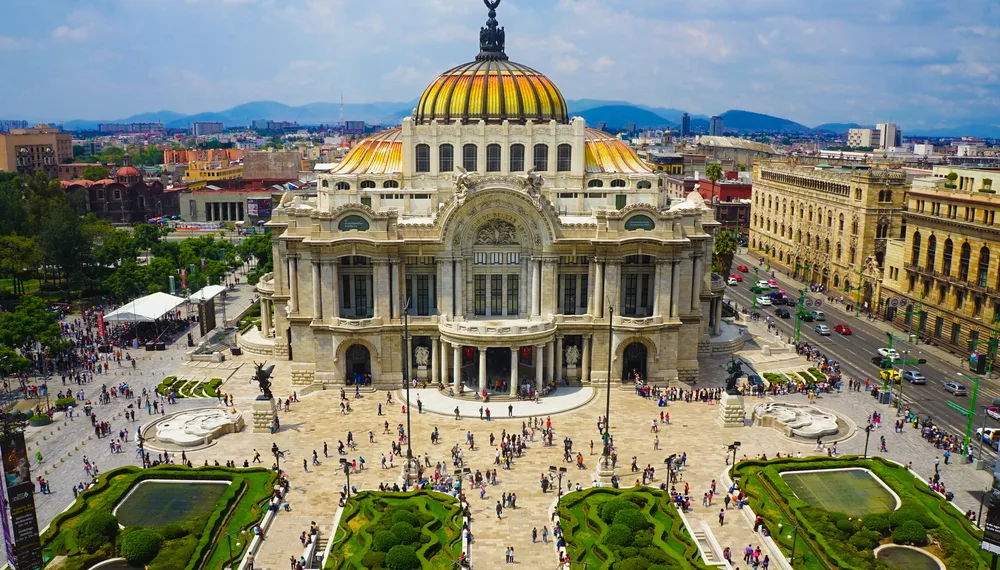
- Mexico has one of the world’s highest crypto adoption rates, largely as a result of its remittance payments.
- Increasingly, however, the local market is showing diversification, suggesting that Mexican crypto users are seeking to add wider resilience to their finances.
- The authorities continue to take a cautious line on crypto, regulating elements of the sector without showing any great support for its wider development.
- For more stories about how and why different countries are adopting crypto, please visit our Crypto in Action pages.
Why Mexico offers fertile ground for crypto
Mexico is a cash-based economy. More than one-half of the country’s population do not have a bank account, with individuals either preferring to literally keep hold of their money or not being able access traditional financial institutions. Furthermore, increasingly onerous banking regulations – implemented since 2019 to counter tax evasion and money laundering – have further deterred potential customers.
Mexico is also a country heavily reliant on remittances. Crypto has, as a result, emerged as the most efficient means to transfer money from overseas, being more cost-effective and swifter than traditional money transfer methods. Remittances to Mexico were forecast to have reached $68.2bn in 2024. The need to transfer this level of funds, coupled with the population’s generally mistrustful attitude towards traditional financial services, has prompted a growing interest in crypto.
As a result, Mexico ranks 14th globally in terms of crypto adoption. It has long been regarded as one of the most active crypto markets in the region. To date, this has largely been attributed to the use of crypto for remittances, but increasingly Mexicans crypto users are using digital assets to add strength and resilience to their finances.
Looking beyond remittances
A report released in March 2025, revealed that 37% of Mexican crypto investors are aged 25-34, and 22% in both the 18-24 and 35-44 age groups. In terms of gender, 74% are men.
The report suggested that the population are diversifying their portfolios beyond the popular bitcoin and Ethereum, and incorporating other digital assets, including memecoins and stablecoins. A total of 41% of Mexican currency exchange, Bitso’s, local customers hold three or more digital assets.
This possibly shows that crypto is becoming regarded as a potential hedge against instability. Many countries use cryptocurrencies as a hedge against inflation, but Mexico’s inflation rate has remained in the low single digits in recent years. The fiat, the peso, is, however, one of the most traded currencies and prone to fluctuation. This increases the attractiveness of stablecoins.
As a result, some Mexican crypto users view cryptocurrencies as a long-term investment and a sound alternative to keeping cash balances in bank accounts.
Seeking to tap into the wider growing interest in tokenizing real-world assets, the Mexican market’s interest in diversification and the fact the country has the second-largest bond market in the region, there is interest in expanding digital asset offerings.
In October 2023, Etherfuse, a protocol that tokenises real-world emerging market bonds, unveiled the government-backed Stablebond, a tokenized bond designed for the country’s individual and retail investors. This marks a shift away from governments, foreign investors and institutions, which account for the vast majority of trading volume.
Crypto isn’t a legal tender in Mexico but can be used for online purchases. As such, there is also a growing interest in paying for goods and services online using crypto, and even for major purchases, like real estate.
The authorities’ attitude towards crypto
Cautious is perhaps the best description of the authorities’ attitude towards the sector. There is no cryptocurrency law, per se. In terms of legislation, the 2018 Law to Regulate Financial Technology Institutions (or Fintech Law), is the key element and marked the country’s first attempt to regulate virtual asset transactions. Beyond this, virtual assets haven’t really been integrated into the wider financial system.
The Fintech Law provides the main regulations regarding virtual assets, with different authorities then responsible for providing the specifics. Among these are the central bank, Banxico, the Ministry of Finance and Public Credit, and the National Banking and Securities Commission.
Crypto is not recognized as legal tender, but there is no ban on virtual asset transactions. That said, financial institutions, such as banks, and exchanges need Banxico’s approval to allow these transactions and must adhere to globally recognized AML and terrorist financing laws. This largely reflects the authorities fears of crypto’s misuse, and they have taken a stronger line on issues like AML and KYC than other countries in the region.
Crypto proponents have argued that the relatively high costs imposed on exchanges seeking to set themselves up in Mexico have limited crypto activity and created barriers to digital asset development.
There has so far been no change in this situation during the presidency of Claudia Sheinbaum. Crypto wasn’t a feature of her 2024 election campaign and given that she is close to her predecessor, Andres Manuel Lopez Obrador, there is little to suggest attitudes have altered.
The ruling Morena Party has proposed no comprehensive legislation for the sector, but it has amended existing laws (notably imposing a 20% tax on cryptocurrency gains), and sought to regulate blockchain with a focus on making it more secure. Taxation is based on the general principles set out in Mexican tax legislation. As such, crypto assets are subject to income tax and crypto-related activities are subject to value-added tax.
Timeline of regulation
2024
In July, the financial consumer protection agency introduced regulations for fintech companies. These included the creation of ‘digital agents’.
In February, Bitso called for changes to the taxation, intellectual property and Fintech laws, seeking greater clarification.
2023
In June, the National Code of Civil and Family Procedures defined terms like ‘blockchain’ and ‘metaverse’ for the first time at a regulatory level.
2022
In April, Governor of Banxico, Victoria Rodríguez Ceja, announced that the bank was creating a Mexican peso digital currency. Two months previously, the government had tweeted that it considered new technologies and their payment infrastructure of the “utmost importance” to supporting financial inclusion.
Also in February, Senator Indira Kempis Martínez, introduced a bill calling for the creation of a CBDC and later proposing that bitcoin be considered legal tender.
2021
In August, regulations were tightened to ensure that non-financial entities carrying out virtual asset transactions were obliged to comply with the Anti-Money Laundering Legal Framework.
In June, Finance Minister Arturo Herrera, reiterated that cryptocurrencies were not legal tender and financial institutions were not authorized to deal with virtual assets. The statement came after Mexican billionaire businessman and crypto supporter, Ricardo Salinas Pliego, said his bank would accept bitcoin.
2019
It was feared that the new Fintech Law (which came into effect in August) would result in the closure of more than 200 listed start-ups, hampering fintech activity in Mexico. Critics regarded the legislation as too restrictive, arguing that exchanges weren’t able to operate under the new law.
In July, the country’s consumer watchdog released new rules for fintech companies, including best practices for cryptocurrencies.
In March, Banxico issued Circular 4/2019, which prohibited banks and financial institutions from directly dealing with virtual assets.
2018
In September, it emerged that the government had been working on a project to track bids for public contracts using blockchain.
In March, the Fintech Law was passed in the lower house, and was awaiting signature into law from the president.
2017
In December, it was announced that the government was planning to introduce legislation to regulate fintech firms, including those working with cryptocurrencies.
2014
In March, Banxico issued a warning about the risks of using virtual currencies and said they were not considered legal tender.
Outlook remains muted for wider adoption
Forecasts suggest that projected revenue in Mexico’s cryptocurrency market will reach $985.5m during 2025 and reach more than 15 million Mexican users. This is still a relatively small number, however, given the country has a population of 129.7 million.
Mexico offers fertile ground for crypto take-up, with the sector providing a practical solution to the country’s lack of financial inclusion. Further adoption is, however, limited to some degree by the general population’s lack of knowledge about, and understanding of, crypto. Simplification of crypto products and processes, the creation of financial apps in indigenous languages, and crypto education are key in this respect.
For now the authorities can be expected to continue taking a cautious approach. There are no signs of a wholehearted embrace of the sector nor further legislation, and its notable that the timeline for programs like the creation of a CBDC have been delayed.

























